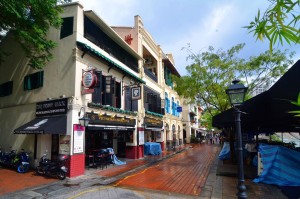Bukit Brown in Singapore HeritageFest 2014
2
For the first time Bukit Brown has been included in the Singapore HeritageFest with partners Singapore Heritage Society.
The walks are free but registration is needed via the Festival website only here
Registration opens 1 July, 2014. Spaces are limited so register early to avoid disappointment!
Bukit Brown in the City
Saturday July 19 & July 26, 4pm – 6.30pm
A number of pioneering settlers of 18th and 19th century colonial Singapore who were buried in the Chinese cemeteries of the Greater Bukit Brown Complex (including the first Chinese Municipal Cemetery) are today still remembered by streets and buildings bearing their name.
The activities and efforts of these movers and shakers – many of whom were members of leading Chinese families in other contemporary European colonies – contributed significantly to colonial Singapore’s transformation, from a regional entrepot port to a modern and globally significant trade and finance hub, the enterprise envisaged at its founding in 1819![]()
“Bukit Brown in the City” , takes you on a guided walk that covers Raffles Place; Boat Quay; Chulia Street (formerly Kling Road); Phillip Street; Telok Ayer Street; Club Street and eventually ending at Bukit Pasoh Road. Experience what life was like and what has changed over the years in old downtown Singapore.
The City in Bukit Brown
Sunday July 20th & 27th, 9am – 11.30am
Between 1922 and the period of the Second World War, a majority of the Chinese residents of Singapore were buried in Bukit Brown cemetery. Some of those buried here, were well-known and distinguished pioneers like Tan Ean Kiam; Gan Eng Seng; Tan Chor Nam; Lim Chong Pang; Tan Kheam Hock; Ong Sam Leong; Tan Boo Liat; See Tiong Wah – and they were leading contributors to the economic, social as well as cultural life of Singapore.
With “City in Bukit Brown”, we invite you to join the “Brownies” who will introduce you to the tombs of these prominent pioneers who landmarked street names and places all over Singapore. Listen to accounts of their lives, their fascinating backgrounds and the endearing legacies they handed down to our generation today.”
*****************************************************************************
About the Guides:
Alex Tan Tiong Hee, “Curator” and lead guide of “Bukit Brown in the City”
Alex, who studied law in England, was brought up on the lap of history. He was very close to his father, the late Tan Yeok Seong, who was a historian and scholar, as well as a publisher of educational textbooks for schools in Singapore. From his father was nurtured, an acute appreciation for the colonial history of Singapore vis-a-vis developments in China at that time Alex, lends to this heritage walk, his personal experience of historical places and the pioneers who are buried in Bukit Brown. Alex is an Executive Committee member of the Singapore Heritage Society.
The Brownies: The Brownies are the volunteers who have been spending their weekends conducting heritage walks at Bukit Brown since 2012. To date, over 11.000 people have visited Bukit Brown in organized walks. Inspired by positive responses from the public, the Brownies would like to spread and share the collective stories of the pioneers in Bukit Brown to the rest of the island. Chew Keng Kiat who is curating “The City in Bukit Brown” has conducted 120 guided walks at Bukit Brown.
More on the walks:
The Bukit Brown in the City and the City in Bukit Brown walks were specially curated for the Singapore Heritage Festival so as to storyboard a direct connection between two places – the City and the Cemetery. The former which stretches from the present Raffles Place to Club Street landmarks the commerce and business networks of our colonial past; the latter, the contributions of pioneers buried in Bukit Brown and our migrant history.
Many of the places within the city which served as offices for banks, shipping and trading houses no longer exist in their original physical form, but they are nonetheless still landmarked by the names of the pioneers who breathed life to them. The handful that still exist physically have been re-purposed to keep up with the times.
Consider “The Arcade” in Raffles Place and the connection with number 26 Boat Quay. The Arcade of yesterday was the offices of Guthrie; 26 Boat Quay – today “Penny Black” – was the business premises of Tan Kim Ching, eldest son of Tan Tock Seng. Both Guthrie and Tan Kim Ching were the builders of the Tanjong Pagar Dockyards – the precursor of what became the Port Authority of Singapore.
Some 10 doors away, 17 Boat Quay (present day OUB concourse) does not exist today, but back in the day it harbored a political fugitive from China. Kang You Wei was the architect of the failed movement to reform and stem the decline of the Imperial Qing from corruption and systemic abuse. The man who provided him refuge, Khoo Seok Wan, was an intellect and poet who inherited his father’s vast fortunes founded on rice trading of which number 17 was the office.
The City was more than just a place of commerce, it was a gathering of prevailing social, economic and political thought congregated at the Goh Loo Club, a gentlemen’s club, the last stop of the walk.
As such the walks are bespoke in nature, drawing on the personal as well as the broad strokes of the historical context of the life and times of the pioneers buried in Bukit Brown, and their web of connections as the elite of the day. But though elitist in make-up, it was their collective actions that had reflected their concerns for the larger populace and how to uplift their lot in life.
In contrast, with the City, the Cemetery has better withstood the test of time until plans were announced for an 8 lane highway which will slice it into half. As a burial ground for the Chinese from as far as back as the late 1800s, the Cemetery with 100,000 graves has been fertile ground for a group of volunteers called “Brownies”, who have been sharing what they have learned about the life stories of the pioneers in the City in their guided walks. The tomb of Tan Kim Ching is inscribed with Qing imperial titles as well as titles from Siam, Japan and Russia.
As a complementary to the City In Bukit Brown, the walk in the Cemetery is a gateway into another dimension of their life stories, the compelling inscriptions and the architecture of the graves.



Hi I would like to go to bukit brown on 19.
Hi Kelly,
Registration is through the HeritageFest website. This the link http://www.heritagefest.org.sg/SHFPortal/
You need to check their website whether there are slots still available. 19 July is the Bukit Brown in the City walk , 20 July is the walk in Bukit Brown.